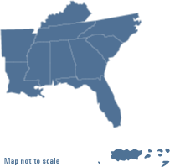West Indian Manatee
(Trichechus manatus)
Have you seen a manatee?
Scientists at Dauphin Island Sea Lab are conducing research fo find out more about manatees in Alabama.To report manatee sightings in Alabama waters, call 1-866-493-5803, or send an email: manatee@disl.org.
Background Information
Description: The West Indian Manatee is a large gray or brown aquatic mammal. Adults average about 10 feet long and weigh 1,000 pounds. They have no hindlimbs, and their forelimbs are modified as flippers. Manatee tails are flattened horizontally and rounded. Their body is covered with sparse hairs and their muzzles with stiff whiskers. Sexes are distinguished by the position of the genital openings and presence or absence of mammary glands. Manatees will consume any aquatic vegetation available to them and sometimes even shoreline vegetation. Although primarily herbivorous, they will occasionally feed on fish. Manatees may spend about 5 hours a day feeding, and may consume 4 to 9 percent of their body weight a day.
Range: During the winter months, the United States' manatee population confines itself to the coastal waters of the southern half of peninsular Florida and to springs and warm water outfalls as far north as southeast Georgia. Manatees also winter in the St. Johns River near Blue Spring State Park. During summer months, they may migrate as far north as coastal Virginia on the east coast and the Louisiana coast on the Gulf of Mexico.
Manatee populations also exist outside the continental United States in coastal areas of the Caribbean and Central and South America. In Puerto Rico, manatees apparently occur around the southern and eastern end of the island and around nearby Vieques Island. Except for rare sightings, manatees seem to be absent from the Virgin Islands at present, but fossils have been found in middens on St. Croix.
Habitat: Manatees inhabit both salt and fresh water of sufficient depth (1.5 meters to usually less than 6 meters) throughout their range. They may be encountered in canals, rivers, estuarine habitats, saltwater bays, and on occasion have been observed as much as 3.7 miles off the Florida Gulf coast. Between October and April, Florida manatees concentrate in areas of warmer water. When water temperatures drop below about 21 to 22 degrees Centigrade, they migrate to south Florida or form large aggregations in natural springs and industrial outfalls. Severe cold fronts have been known to kill manatees when the animals did not have access to warmwater refuges. During warmer months they appear to choose areas based on an adequate food supply, water depth, and proximity to fresh water. Manatees may not need fresh water but they are frequently observed drinking fresh water from hoses, sewage outfalls, and culverts. There is no evidence of any periodicity in manatee habitat use in Puerto Rico.
Status: Endangered, Federal Register, March 11, 1967, June 2, 1970
Source: Endangered and Threatened Species of the Southeastern United States (The Red Book) FWS Region 4 -- As of 8/93
Other links:
- Manatee - Sirenia Project (USGS--Florida Integrated Science Center)
- USGS--Florida Integrated Science Center Photo Gallery
- USFWS Jacksonville Field Office
- Dauphin Island Sea Lab Manatee Sighting Network


